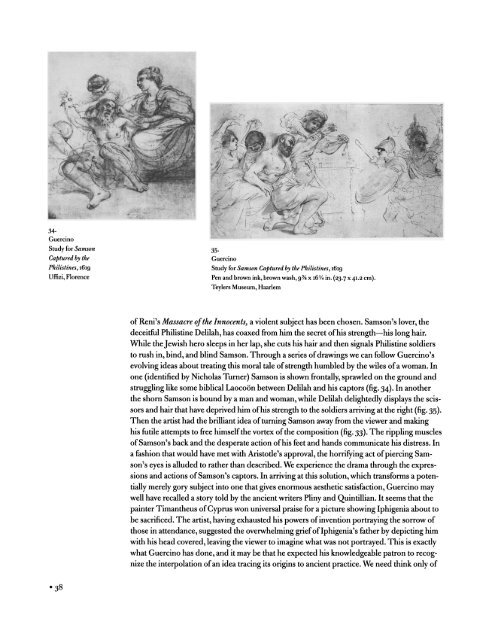GOING FOR BAROQUE Into the Bin - The Metropolitan Museum of Art
GOING FOR BAROQUE Into the Bin - The Metropolitan Museum of Art
GOING FOR BAROQUE Into the Bin - The Metropolitan Museum of Art
You also want an ePaper? Increase the reach of your titles
YUMPU automatically turns print PDFs into web optimized ePapers that Google loves.
34<br />
Guercino<br />
Study<br />
for Samson<br />
Captured by <strong>the</strong><br />
Philistines, 1619<br />
Uffizi, Florence<br />
35<br />
Guercino<br />
Study<br />
for Samson<br />
Captured by <strong>the</strong> Philistines, 1619<br />
Pen and brown ink, brown wash, 9%<br />
Teylers <strong>Museum</strong>, Haarlem<br />
x 16 XA in. (23.7 x 41.2 cm).<br />
<strong>of</strong> Reni's Massacre<br />
<strong>of</strong> <strong>the</strong> Innocents, a violent subject has been chosen. Samson's lover, <strong>the</strong><br />
deceitful Philistine Delilah, has coaxed from him <strong>the</strong> secret <strong>of</strong> his<br />
strength?his long hair.<br />
While <strong>the</strong> Jewish hero<br />
sleeps<br />
in her<br />
lap, she cuts his hair and <strong>the</strong>n signals<br />
Philistine soldiers<br />
to rush in, bind, and blind Samson.<br />
a<br />
Through<br />
series <strong>of</strong> we can drawings<br />
follow Guercino's<br />
evolving<br />
ideas about<br />
treating<br />
this moral tale <strong>of</strong> strength<br />
humbled<br />
by<br />
<strong>the</strong> wiles <strong>of</strong> a woman. In<br />
one<br />
(identified by Nicholas Turner)<br />
Samson is shown<br />
frontally, sprawled<br />
on <strong>the</strong> ground<br />
and<br />
struggling<br />
like some biblical Laoco?n between Delilah and his captors (fig. 34).<br />
In ano<strong>the</strong>r<br />
<strong>the</strong> shorn Samson is bound<br />
by a man and woman, while Delilah<br />
delightedly displays<br />
<strong>the</strong> scis<br />
sors and hair that have deprived<br />
him <strong>of</strong> his<br />
strength<br />
to <strong>the</strong> soldiers<br />
at<br />
arriving<br />
<strong>the</strong> right (fig. 35).<br />
<strong>The</strong>n <strong>the</strong> artist had <strong>the</strong> brilliant idea <strong>of</strong> turning<br />
Samson away from <strong>the</strong> viewer and making<br />
his futile attempts to free himself <strong>the</strong> vortex <strong>of</strong> <strong>the</strong> composition (fig. 33).<br />
<strong>The</strong><br />
rippling<br />
muscles<br />
<strong>of</strong> Samson's back and <strong>the</strong> desperate<br />
action <strong>of</strong> his feet and hands communicate his distress. In<br />
a fashion that would have met with Aristotle's approval, <strong>the</strong> horrifying<br />
act <strong>of</strong> piercing<br />
Sam<br />
son's eyes is alluded to ra<strong>the</strong>r than described. We<br />
experience<br />
<strong>the</strong> drama<br />
through<br />
<strong>the</strong> expres<br />
sions and actions <strong>of</strong> Samson's captors. In arriving<br />
at this solution, which transforms a poten<br />
tially merely gory subject<br />
into one that enormous gives<br />
aes<strong>the</strong>tic satisfaction, Guercino may<br />
well have recalled a story told by<br />
<strong>the</strong> ancient writers Pliny<br />
and Quintillian.<br />
It seems that <strong>the</strong><br />
painter Timan<strong>the</strong>us <strong>of</strong> won Cyprus<br />
universal<br />
praise<br />
for a picture showing Iphigenia<br />
about to<br />
be sacrificed. <strong>The</strong> artist, having<br />
exhausted his powers <strong>of</strong> invention<br />
portraying<br />
<strong>the</strong> sorrow <strong>of</strong><br />
those in attendance, suggested<br />
<strong>the</strong> overwhelming grief<br />
<strong>of</strong> Iphigenia's<br />
fa<strong>the</strong>r by depicting<br />
him<br />
with his head covered, leaving<br />
<strong>the</strong> viewer to imagine<br />
what was not portrayed.<br />
This is exactly<br />
what Guercino has done, and it may be that he expected<br />
his knowledgeable patron<br />
to recog<br />
nize <strong>the</strong> interpolation<br />
<strong>of</strong> an idea<br />
tracing<br />
its origins<br />
to ancient<br />
practice. We need think only<br />
<strong>of</strong><br />
38
















